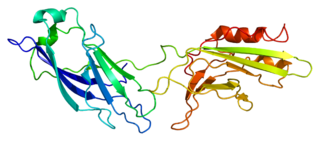| SYT2 | |||||||||||||||||||||||||||||||||||||||||||||||||||
|---|---|---|---|---|---|---|---|---|---|---|---|---|---|---|---|---|---|---|---|---|---|---|---|---|---|---|---|---|---|---|---|---|---|---|---|---|---|---|---|---|---|---|---|---|---|---|---|---|---|---|---|
| Identifiers | |||||||||||||||||||||||||||||||||||||||||||||||||||
| Aliases | SYT2 , SytII, CMS7, MYSPC, synaptotagmin 2, CMS7A, CMS7B | ||||||||||||||||||||||||||||||||||||||||||||||||||
| External IDs | OMIM: 600104 MGI: 99666 HomoloGene: 22516 GeneCards: SYT2 | ||||||||||||||||||||||||||||||||||||||||||||||||||
| |||||||||||||||||||||||||||||||||||||||||||||||||||
| |||||||||||||||||||||||||||||||||||||||||||||||||||
| |||||||||||||||||||||||||||||||||||||||||||||||||||
| |||||||||||||||||||||||||||||||||||||||||||||||||||
| Wikidata | |||||||||||||||||||||||||||||||||||||||||||||||||||
| |||||||||||||||||||||||||||||||||||||||||||||||||||
Synaptotagmin-2 is a protein that in humans is encoded by the SYT2 gene. [5] [6]
| SYT2 | |||||||||||||||||||||||||||||||||||||||||||||||||||
|---|---|---|---|---|---|---|---|---|---|---|---|---|---|---|---|---|---|---|---|---|---|---|---|---|---|---|---|---|---|---|---|---|---|---|---|---|---|---|---|---|---|---|---|---|---|---|---|---|---|---|---|
| Identifiers | |||||||||||||||||||||||||||||||||||||||||||||||||||
| Aliases | SYT2 , SytII, CMS7, MYSPC, synaptotagmin 2, CMS7A, CMS7B | ||||||||||||||||||||||||||||||||||||||||||||||||||
| External IDs | OMIM: 600104 MGI: 99666 HomoloGene: 22516 GeneCards: SYT2 | ||||||||||||||||||||||||||||||||||||||||||||||||||
| |||||||||||||||||||||||||||||||||||||||||||||||||||
| |||||||||||||||||||||||||||||||||||||||||||||||||||
| |||||||||||||||||||||||||||||||||||||||||||||||||||
| |||||||||||||||||||||||||||||||||||||||||||||||||||
| Wikidata | |||||||||||||||||||||||||||||||||||||||||||||||||||
| |||||||||||||||||||||||||||||||||||||||||||||||||||
Synaptotagmin-2 is a protein that in humans is encoded by the SYT2 gene. [5] [6]

Synaptotagmins (SYTs) constitute a family of membrane-trafficking proteins that are characterized by an N-terminal transmembrane region (TMR), a variable linker, and two C-terminal C2 domains - C2A and C2B. There are 17 isoforms in the mammalian synaptotagmin family. There are several C2-domain containing protein families that are related to synaptotagmins, including transmembrane (Ferlins, Extended-Synaptotagmin (E-Syt) membrane proteins, and MCTPs) and soluble (RIMS1 and RIMS2, UNC13D, synaptotagmin-related proteins and B/K) proteins. The family includes synaptotagmin 1, a Ca2+ sensor in the membrane of the pre-synaptic axon terminal, coded by gene SYT1.

A C2 domain is a protein structural domain involved in targeting proteins to cell membranes. The typical version (PKC-C2) has a beta-sandwich composed of 8 β-strands that co-ordinates two or three calcium ions, which bind in a cavity formed by the first and final loops of the domain, on the membrane binding face. Many other C2 domain families don't have calcium binding activity.

Inositol 1,4,5-trisphosphate receptor type 1 is a protein that in humans is encoded by the ITPR1 gene.

Synaptotagmin-1 is a protein that in humans is encoded by the SYT1 gene.

Synaptotagmin-binding, cytoplasmic RNA-interacting protein (SYNCRIP), also known as heterogeneous nuclear ribonucleoprotein (hnRNP) Q or NS1-associated protein-1 (NSAP-1), is a protein that in humans is encoded by the SYNCRIP gene. As the name implies, SYNCRIP is localized predominantly in the cytoplasm. It is evolutionarily conserved across eukaryotes and participates in several cellular and disease pathways, especially in neuronal and muscular development. In humans, there are three isoforms, all of which are associated in vitro with pre-mRNAs, mRNA splicing intermediates, and mature mRNA-protein complexes, including mRNA turnover.

Ras-related protein Rab-8A is a protein that in humans is encoded by the RAB8A gene.

Synaptotagmin-like 2, also known as SYTL2, is a human gene.

Synaptotagmin-3 is a protein that in humans is encoded by the SYT3 gene.

Synaptotagmin-9 is a protein that in humans is encoded by the SYT9 gene.

Synaptotagmin-11 is a protein that in humans is encoded by the SYT11 gene.

Synaptotagmin-5 is a protein that in humans is encoded by the SYT5 gene.

Synaptotagmin-like protein 1 is a protein that in humans is encoded by the SYTL1 gene.

Synaptotagmin-13 is a protein that in humans is encoded by the SYT13 gene.

Synaptotagmin-4 is a protein that in humans is encoded by the SYT4 gene.

Synaptotagmin-7 is a protein that in humans is encoded by the SYT7 gene.

Ras-related protein Rab-27A is a protein that in humans is encoded by the RAB27A gene.

Synaptotagmin-6 is a protein that in humans is encoded by the SYT6 gene.

Exophilin 5, also known as EXPH5, is a human gene.

Synaptotagmin XIV is a protein that in humans is encoded by the SYT14 gene.

Kelch-like protein 3 is a protein in humans that is encoded by the KLHL3 gene. Alternative splicing results in multiple transcript variants encoding distinct isoforms.